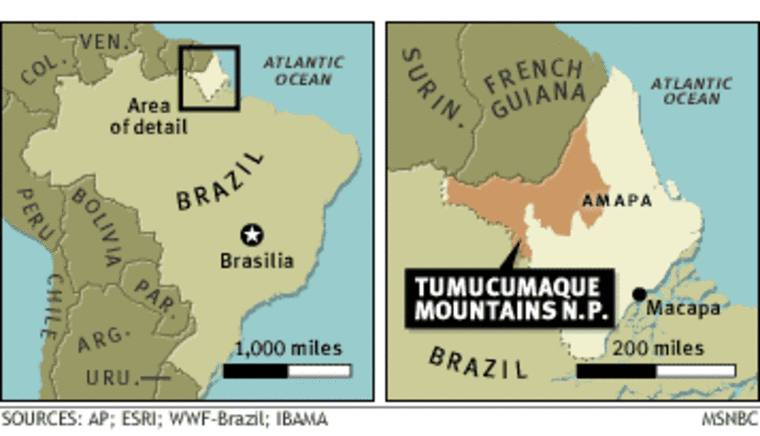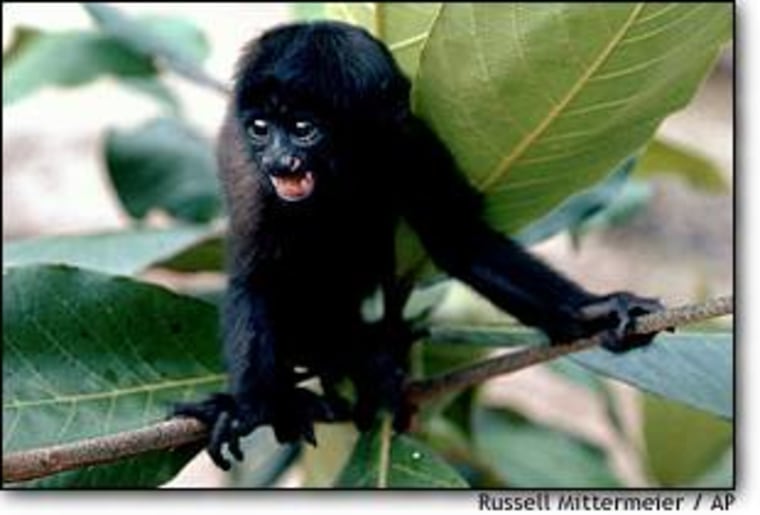A northern swath of Amazon rainforest bigger than Maryland and containing at least 350 bird species became the world’s largest tropical national park Thursday. President Fernando Henrique Cardoso signed a decree creating the Tumucumaque Mountains National Park covering a virtually uninhabited region of virgin rainforest in Amapa state, along Brazil’s northern borders with Suriname and Guyana.
Tumcumaque, which means “the rock on top of the mountain” in the language of the Apalai and Wayana Indians, covers 9.6 million acres of forest-blanketed mountains with granite outcroppings rising up to 2,300 feet above the forest canopy.
“With the creation of Tumucumaque Mountains National Park, we are ensuring the protection of one of the most pristine forests remaining in the world,” Cardoso said. “Plants and animals that may be endangered elsewhere will continue to thrive in our forests forever.”
Part of summit plans
The move is one of several environmental measures the government is preparing ahead of the World Summit on Sustainable Development, which starts Monday in Johannesburg, South Africa.
Cardoso also signed several laws regulating the use of genetic material gathered from Brazil’s immense variety of plant and animal species.

At the 10-day summit, Cardoso is expected to announce the Amazon Region Protected Areas program, putting nearly 200,000 square miles - including Tumucumaque — under federal protection in national parks and sustainable development reserves.
Tumucumaque park is 568,000 acres larger than Slonga National Park in the Democratic Republic of Congo, previously the world’s largest tropical park.
The forest is inhabited by jaguars, sloths, giant armadillos, anteaters, harpy owls and black spider monkeys. Scientists know of at least eight primate species, 350 bird species and 37 types of lizard living in the park.
“I don’t have any doubt the park will yield new species,” said Jose Pedro de Oliveira Costa, secretary for biodiversity and forests at Brazil’s Environment Ministry.
No roads
A number of environmental groups helped create the park, including the World Wide Fund for Nature and Conservation International.
“The park is very important because it helps consolidate one of the world’s last roadless wildernesses,” said Roberto Cavalcanti, director of Conservation International in Brazil. “Much of the Amazon is still wild, but there are roads running through it.”
In much of the Amazon, roads have accelerated destruction of the forest by providing access for settlers, prospectors and loggers. Deforestation has destroyed about 15 percent of Brazil’s Amazon rainforest, which today covers about 1.35 million square miles.
Tumucumaque is full of waterfalls, whitewater rapids and rivers that are impassible even during the dry season, making it one of the few remaining regions largely unchanged by humans.
“This park today looks much like it would have hundreds of years ago, since Tumucumaque has not been deforested,” said Jose Maria Cardoso da Silva, Conservation International’s director for Amazonia.

Still need cash
Costa hopes millions of dollars in promised funding from the World Bank and Global Environmental Facility will help Tumucumaque avoid the fates of other parks in the Amazon, where a shortage of forest rangers and infrastructure has made parks vulnerable to illegal mining and logging and virtually inaccessible to the general public.
“We want Tumucumaque to be the first of a series of parks that include visitors and ecotourism. We want to give it model treatment, everything we think is necessary for a park,” Costa said.
Initially, the park will be open only to scientists, who will study how best to combine tourism with preservation.
“This is an opportunity that doesn’t come along very often,” said Garo Batmanian, chief executive officer of the World Wild Fund for Nature. “Because most of the land in the Amazon is still in the government’s hands, the environment can still have a vision for zoning the Amazon.”
